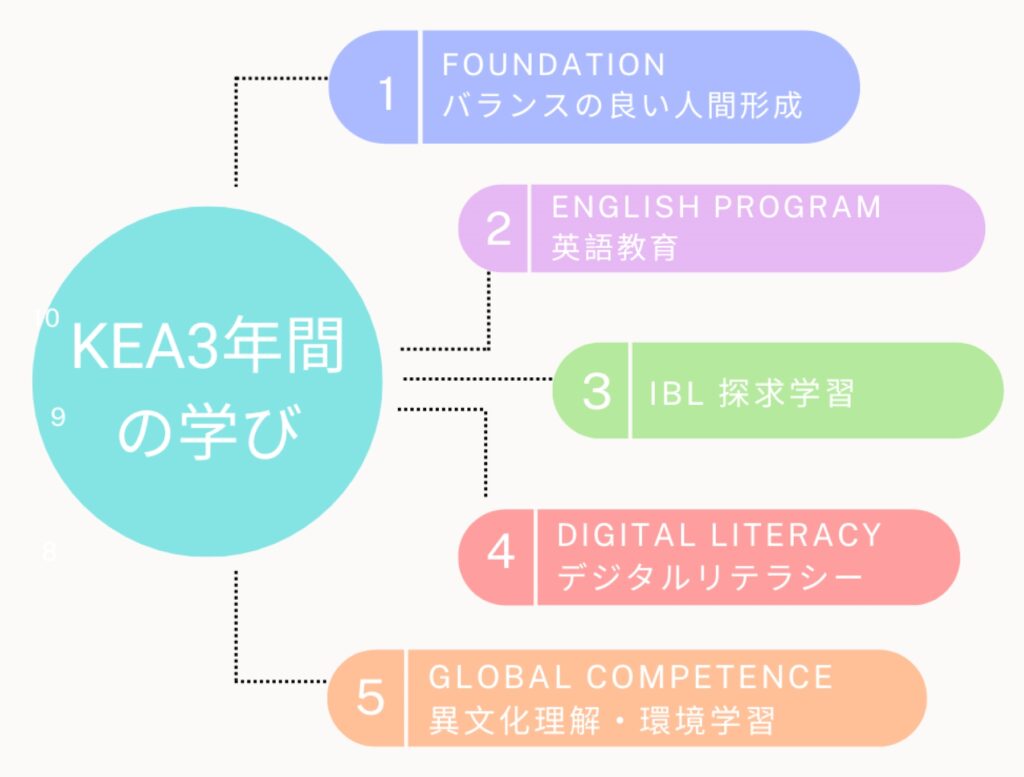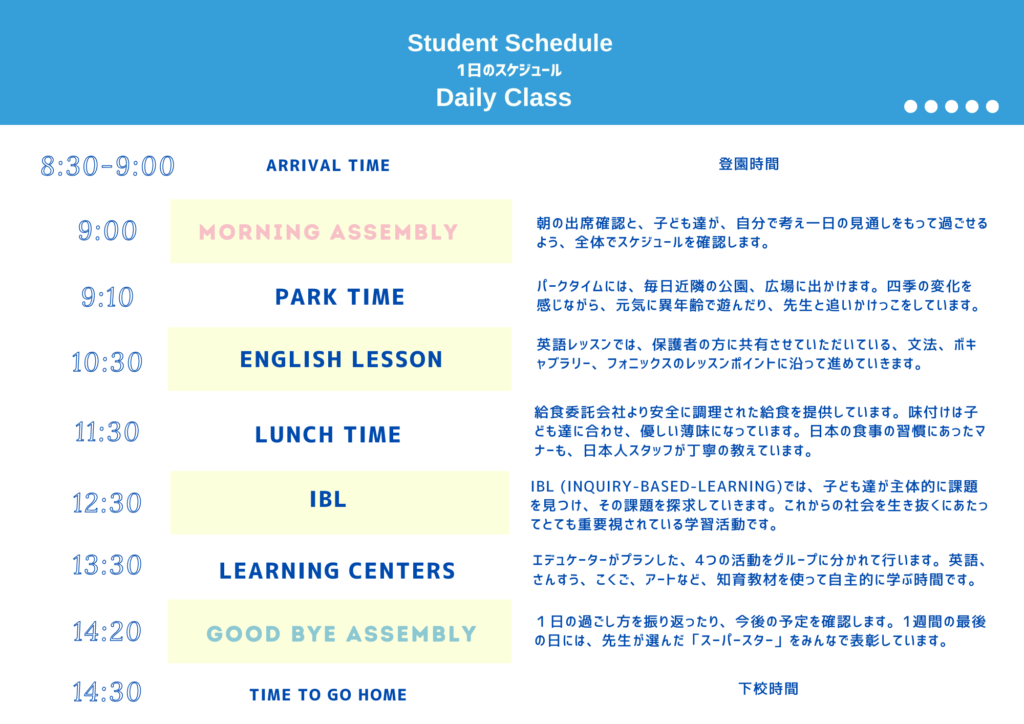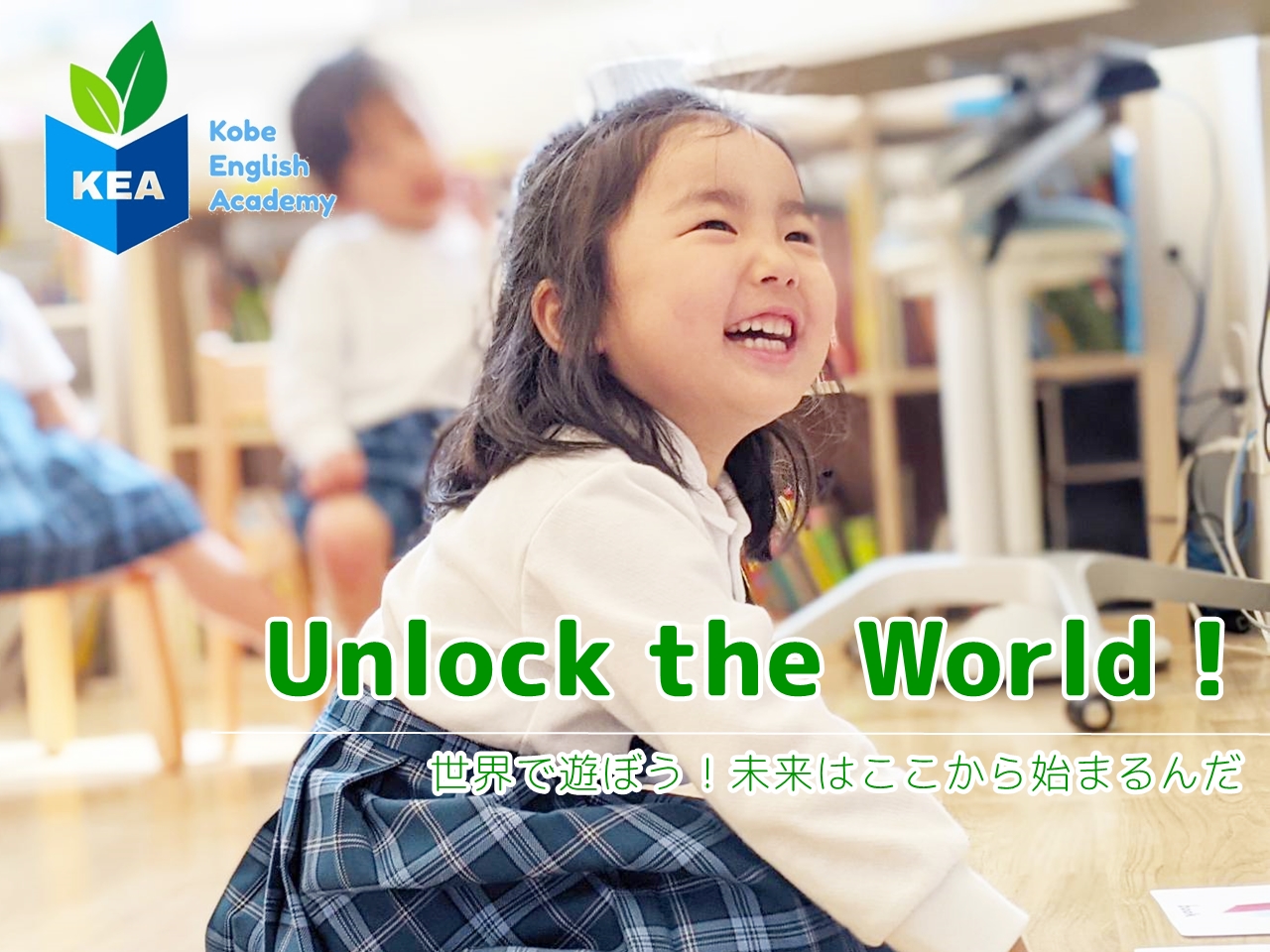DAILY CLASSの詳細
~KEAは幼児保育無償化対象施設です。対象の方は¥37,000の補助が受けられます~
未来のGlobal Citizen(世界の市民)へ


KEAは、バイリンガルスクールでありながら、文科省の「幼児期の終わりまでに育ってほしい10の姿」に添った指導を行っています。
私たちのこれまでのインターナショナルスクールでの指導経験から、取り入れたいと考えていたことは、丁寧な日本の幼児期の教育をベースにすることでした。
子ども達は、周りの大人の声掛けや環境の質が良ければ目に見えて成長していきます。心身頭のバランスの良い成長を丁寧に導いていくため、1クラス16名までの少人数クラスに、1~2名のエデュケーターが見守り、一人ひとりの子ども達の変化を見逃さない環境を作っています。
子ども達にとって一生涯大切な価値になる「相手の話を聞き、自分の考えを伝える」土台を作ります。


KEAのプログラムは、アメリカの小学校と同等のレベルのリーディング、ライティング、フォニックスの教材を利用してカリキュラムを監修しています。カリフォルニア州の州共通基準を英語教育の基準としています。
KEAの英語教育では、英語を母国語としない子どもたちが第2言語として英語を学ぶ単語習得を主な内容の1つとしていること以外は、海外での教育と同等の内容やレベルで英語教育を行っています。
そのため、KEAで学ぶ3年間で、しっかりとした英語の基礎が身に付き、海外スクールへの編入、卒業後のインターナショナルスクールへの進学がスムーズです。また、国内のジュニア英検、英検にチャレンジする生徒のサポートも行っています。

Inquiry-based Learningとは、子ども達が主体的に課題を見つけ、その課題を探求的に学習する、近年注目されている学習活動の一つです。エデュケーターやクラスメイトとのより深い対話を必要とするクラスのため日本語で行っていきます。
知識を受け身で覚える伝統的な教育とは対照的に、何が起こるかわからない不確実な未来と言われる今の社会に生きていく子ども達には、その時々で課題を捉え、試行錯誤しながら、解決に導いたり物事を生み出す経験が必要です。
KEAでは、IBL学習の時間に、課題設定や、解決策を導く思考力と行動力を幼少期から習慣化する訓練を行っていきます。活動を通じてさまざまな教科を横断し、日本語の読み書きの力も自然に身に付きます。

生まれた時からデジタル環境に囲まれて生きている子ども達にとって、テクノロジーを理解し、使いこなす力は避けては通れない道と考えます。
テクノロジーを安全に使うことや、何ができるのかを知ることが、これからの時代の担い手となる子どもに必要です。驚くほど速いスピードでテクノロジーが日々進化している社会で、想像して作ることができないものはないほど、デジタル世界の可能性は無限大です。子ども達が大人になる頃には、あらゆる業界で新しい物やサービスを作り出す社会になることは明らかです。
テクノロジーの進化と共に、子ども達を取り巻く学びの環境も、VR/AR、メタバース、生成AIを使った学習、使う側から創る側への教育など、大きく変わってきています。KEAでは、幼児期から少しずつ慣れ親しみ、デジタルリテラシーをサポートする環境を取り入れています。

テクノロジーの進化により、地球のどこからでも様々な映像や情報が瞬時に手に入り、スマートフォン1つで世界中の人とつながれ、海外に行くことが無くても、日本国内の環境も多様な国籍の人と学び働くように大きく変わりました。
異文化と出会い上手く交流し、グローバルな課題に取り組んでいくことのできる能力が必要な時代には、グローバル・コンピテンスに意識して理解していくことが大切です。KEAでは、子どもたちに環境問題や異文化が身近になるような機会を積極的に取り入れています。
OECD は、世界の約 80 ヵ国の 15 歳を対象に実施している PISA(Program for International Student Assessment: 国際学習到達度調査)において、2018 年度より「グローバル・コンピテンス」(Global Competence)を調査対象としています。
OECD URL https://www.oecd.org/pisa/innovation/global-competence/
Multiple Choices 選べる卒業後の進路について
KEAの卒業後は、日本の私立・公立校、インターナショナルスクール、いずれの進学先も選択が可能となります。
インターナショナルの特性だけではなく、日本の幼児教育で実践される【幼児期の終わりまでに育ってほしい10の姿】を取り入れ、日本の社会に求められる知識や習慣、日本語の語彙で表現する力、日本が誇るマナーや自律精神、丁寧で細やかな気配りも、経験豊富なエデュケーターがサポートし、幼児教育と小学校教育の円滑な接続を行っています。KEA卒業後の進路は、多岐に渡っており、インターナショナルスクールへの進学、私立小学校受験にチャレンジをする生徒は、例年第一志望校に合格しています。
【KEA生のこれまでの進学先】
インターナショナルスクール:Deutsche Schule Kobe International、Canadian Academy、Marist Brothers International School、 St. Michael International School、その他海外のスクールへの推薦
私立・その他のスクール:公立小学校、中華同文、関西学院大学初等部、海星女学院小学校、甲南小学校、小林聖心女子学院、愛徳学園小学校、神戸大学付属小学校
Schedule 1日のスケジュール例

14:30以降は、After Classでのお預かりが可能です
Annual Events(年間行事)

学費・コース

